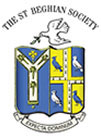|
 |
The Old St Beghian | |
| July 2017 | |||
Chris Grice (G 55-61)
has sent some memories of the CCF-RAF section.
“The reference to the primary glider in the January 2017 issue of the OSB Bulletin prompts me to offer some reminiscences of my time in the RAF section of the CCF. It was during my time in the CCF that we actually acquired the glider (also known as a Grasshopper). It took an inordinate amount of effort to move the parts of the glider from its shed in School House Lane and assemble it on the Crease. On one of its earlier ‘flights’, piloted by the intrepid Flt. Lt. ‘Spike’ Cawthorn RAFVR, who was in charge of the RAF section, we managed to knock down a set of rugby goalposts on ‘Seconds’.
Actually, the RAF section had a lot to recommend it. For example, on Field Days, instead of bashing around the Lakeland fells carrying a .303 and a few blank cartridges, we were bussed to RAF Silloth; had lunch in the Officers’ Mess and then were treated to a flight over the Lake District above the Army section doing their thing below. My very first flight was in a DC3 Dakota, probably one of the most successful aircraft of all time.
I also attended three annual camps at various RAF stations. The first, at RAF Spitalgate, at Grantham, was fairly unremarkable, except for a visit to a V Bomber base at RAF Wittering, where we were allowed to get fairly close to their Vickers Valiants. For train-spotters like myself, the proximity of the main London to Edinburgh line was also an attraction. A couple of years later I went to RAF Benson, in Oxfordshire, which was a Transport Command station and also the base of The Queen’s Flight. While we were there we were able to fill up the spare seats on ‘taxi’ flights, which in my case took us to Shropshire, Silloth near Carlisle, Aldergrove in Northern Ireland and back to Benson. At this camp, we also had a visit to Heathrow Airport, which included a visit to the control tower and the BOAC hangers, where we were allowed to crawl all over a Britannia. I doubt if this would be possible these days. We spent that afternoon at the Aeronautical Museum in South Kensington. Since this camp included the August Bank Holiday Monday, we were taken to the motor cycle races at Thruxton for the day.
My final camp, in 1961, was at RAF Cranwell, which is the base for RAF Officer Training. We were able to see the passing out parade of the newly commissioned officers and then had the doubtful privilege of being instructed by the NCOs, who normally trained the officer cadets. One of the highlights of this camp was a seven-a-side rugby tournament, which St Bees won. In this, I had the privilege of playing with a future captain of England. (This was P. J. Dixon - FS 56-63.)”
Home
The St Beghian Society
St Bees School,
St Bees, Cumbria, CA27 0DS.
Tel: (01946) 828093 Email: osb@stbeesschool.co.uk
Web: www.st-beghian-society.co.uk
![]()